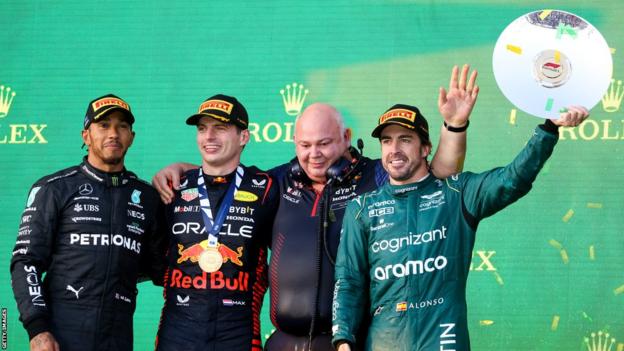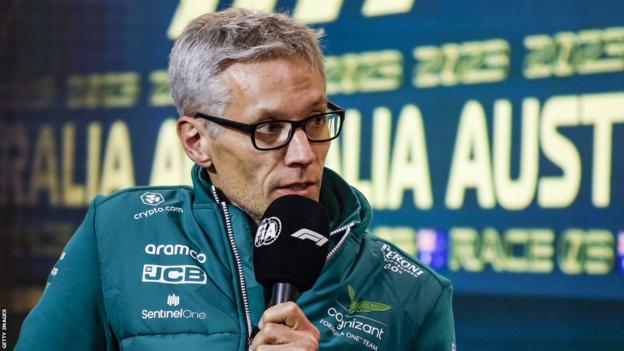
Fernando Alonso’s contribution to Aston Martin’s leap to the podium in Formula 1 this season is “something we must not underestimate”, says team principal Mike Krack.
Alonso has taken three podiums in three races at the start of 2023 to put Aston Martin, who finished seventh last year, second in the constructors’ championship behind Red Bull.
Krack says the 41-year-old two-time champion has had a transformative effect on a team who have also made a major step forward with their car.
“From the first day, he brought a lot of extra energy, a lot of extra motivation to the team,” Krack tells BBC Sport, “just by the way he is and the way he is approaching it. He’s very, very positive.
“If you lead by example, it’s very simple to lead. If you say, ‘The team has to push, but I am on the beach’ it is much more difficult to get the team to push than if the driver is there as well.
“Fernando is the first there in the morning and is the last to leave.
“These are little things, where as a team you realise: ‘Oh, here is someone who’s serious about what he’s doing.’ He’s infecting everybody like that.
“This helps us to extract the last 5-10% from everybody, because if you see the driver is pushing so much, well, if the driver is already so motivated, we will be as well, because normally you always try to get the drivers to push more. He is really the opposite.”
Performance director Tom McCullough says Alonso’s economy of language and precision of expression have also been instrumental as the team seek to understand and begin to develop their car.
“He has got a wealth of experience and he’s very efficient with how he talks and what he wants from the car, the team, everything,” McCullough says.
“He has been there, done it, got the T-shirt. So when he talks, it’s worth listening to. He is really wanting this project to work. So he is saying: ‘Look at this area; it is not our strong point. Look at this.’ That helps lift the team.
“He knows how to talk in a way that the people listening will understand and react to. And that’s a really great skill to have as a driver, because nowadays hundreds of people listen to what they say.”
The road to the front
Alonso had not intended to leave Alpine, who he helped to fourth place last year.
But when the French team dragged out negotiations over a new contract, refusing to give the Spaniard the two-year deal he desired, he ran out of patience and quickly did a deal with Aston Martin after Sebastian Vettel announced his retirement.
Alonso first drove last year’s Aston Martin in a post-season test in Abu Dhabi. There, Krack says, he “realised the car was much better than he was expecting”.
Alonso, who has said he did not expect this level of performance from Aston Martin until next year, threw himself into work with his new team.
Krack adds: “He went away and thought maybe he was underestimating the team.
“But all in all he was sincere since he was with us. He has been pushing himself very hard and this helps us as well. If you have someone relentlessly pushing with that hunger to perform and to win, this is motivating us.”
Progress by F1 teams is usually a matter of inching forwards through steady, patient growth.
The new Williams team principal, James Vowles, made that very point at the season-opening Bahrain Grand Prix when he was discussing the size of the task facing him in his new role following his switch from Mercedes.
When it was pointed out to Vowles that Aston Martin had made a step in performance of a size rarely seen, his response was to point out: “They have an incredible driver.”
But a driver, no matter how good, is ultimately defined by his car’s performance, and Aston Martin’s progression is about a lot more than signing Alonso. It has come about after four years of investment and restructuring, centred on a major recruitment programme.
Krack is one of several senior figures who have joined Aston Martin following Canadian billionaire Lawrence Stroll’s takeover of the team in the summer of 2018, when he bought what was then known as Force India after it went into administration.
Stroll renamed the team Racing Point, before rebranding it as Aston Martin for 2021 following his takeover of the iconic British sportscar company.
The team finished seventh in 2021 and again in 2022. But even those statistics disguise how far they have come in a year.
Alonso spent Sunday’s Australian Grand Prix battling with Lewis Hamilton’s Mercedes for second place.
By contrast, Aston Martin left Melbourne last year, as Krack puts it, “last in the championship with close to the slowest car”.
It led to a reassessment that has culminated in this season’s improved performance.
Krack says: “We said: ‘What are the weaknesses and how do we address them, step by step?’
“There was no magic.”
Krack points out substantial progress had already been made through 2022.
Vettel and team-mate Lance Stroll, Lawrence’s son, ended last season fighting on track at most races with Alpine and McLaren, who were disputing fourth place in the championship.
Krack believes Aston Martin have been flattered by Ferrari and Mercedes making less progress than they might have done over the winter.
“What I think happened,” he says, “was that maybe others didn’t get it 100% right yet. I’m saying ‘yet’ on purpose.
“This allowed us to make that jump from seven to two, but probably it is more from four/five, maybe one or two positions, depending on how others have done their job.”
It’s a fair point, but it rather underestimates Aston Martin’s achievement.
Over the last four races of 2022, Aston Martin were on average 1.546 seconds a lap slower than Red Bull in qualifying. Over the first three of this season, that gap has been slashed to just 0.5secs.
That’s a net gain of one second on a team that has produced one of the greatest cars F1 has ever seen.
Aston have made similar progress compared to Ferrari and Mercedes, who have both fallen slightly back from Red Bull by the same comparison.
Krack has overseen the team for a little over a year, having joined in February 2022, following the departure of Otmar Szafnauer a month earlier.
Stroll recruited former McLaren team principal Martin Whitmarsh as chief executive officer in September 2021.
And the quantum leap forward by the car has been overseen by technical director Dan Fallows and his deputy Eric Blandin.
Fallows, formerly Red Bull’s head of aerodynamics, was signed in June 2021, and started work in April 2022. Blandin committed in November 2021 and joined in July last year.
They were recruited by Andrew Green, the former chief technical officer, who over the winter was moved sideways into another role without direct involvement in the F1 team.
Krack says: “What is really remarkable about people like Dan or Eric is they managed to get more out of the people we had. They left creative space for them.
“They are not the kind of people who arrive and say: ‘This is how I have done it and this is how we do it.’ But they came and they had a look at what was there and they realised there is quality in this team.”
What does “leaving creative space” mean?
“Encouraging, giving confidence,” Krack says. “Letting people develop their own solutions, using the experience of these people and guiding them to find their own solutions.
“This is an art and it needs extremely strong management skills because it would be so easy to say: ‘We do it the way I know it.'”
Interestingly, Fallows and Blandin come from teams who took dramatically different approaches not only to the new technical regulations introduced in F1 for 2022, but also to the previous set of rules. And yet they seem to have blended extremely effectively.
McCullough says: “Part of Andrew Green’s aim was to have that impact from the two strongest teams at the time when he was doing the recruitment.
“It’s a matter of: ‘How were we doing things, how are you doing things, and what is the best way forwards?’
“Dan often refers to: ‘Let’s have the Aston Martin way, not just do the Mercedes way, the Red Bull way. Let’s have our own way.’
“We’re doing what we think is right based on our understanding. Because if you’re going to fight at the front, ultimately you can’t just do what other teams do. You have to do your own thing.”

A new normal
Moving from a team battling in the midfield – whether at the back of it, or at the front – to fighting regularly for podiums requires a very different mindset.
Krack says: “At the end of last year in Abu Dhabi, we said: ‘We will need to learn not to be the underdogs any more. Performing will be have to be the normal.’ It is something that you need to discuss a lot with the people. You need to address it on all levels.
“This is a process that does not change from one day to the next.
“To achieve that, you need to have a couple of success moments. Moments to build your confidence in yourself and confidence in your team. And to do that you have to keep things simple and extract the maximum of what you have, not making any new inventions.”
McCullough, who has been with the team through their various guises for almost 10 years, points out success is not totally out of their experience.
Racing Point were podium contenders in 2020, too, with the controversial “pink Mercedes” car – they even won a race with Sergio Perez in Bahrain at the end of the year. And McCullough says the core of the team remains the same, regardless of the significant movements at management level.
“In a way, although the spotlight is on you more, sometimes it is easier when you have the pace margin to wait until everybody else pits and you just pit from there,” McCullough says.
“In the midfield, when you are not quite as fast as you want to be, it’s sometimes tougher from a race weekend operational side of things. But you are much more in the spotlight when things go wrong. You make a strategy decision when there is a difference between a podium or not, or even race wins.
“Red Bull are a lot stronger than us at the moment. But over the balance of 23 races, with strategic decisions and reliability, we have got to be as we were that day in Bahrain when Sergio won. You’ve got to make the decisions to try to make the most of it.”
His answer is as good a demonstration as any of just how far Aston Martin have come.
From a year spent first battling towards the back, and then inching towards the front of the midfield, the team are now scoring regular podiums and aware of the fact that a win is a real possibility this year, even if it will require Red Bull to hit trouble to achieve it.
That’s a remarkable achievement in itself, but the team – and especially owner Stroll – want more.
Ask Krack what Stroll’s reaction to this new-found success has been, and he says with a smile: “What do you think? The references have completely changed.
“Lawrence being Lawrence, this is the new normal. ‘How can we get to the front?’ Lawrence is not the guy who tells us, ‘You did a good step’ or, ‘Now we hold this and see how we move on?’ No, no. How do we get from here to where he wants to go as quick as possible?”

